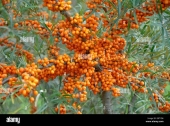
 4
4




The roots are located near the soil surface. The majority of the roots are located at a depth of 30 cm. The root system is much wider than the crown of the plant, reaching sometimes up to 4 m. Root system is fibrous, slightly branched.
 4
4




 5
5




 5
5




Flora Eerschay wrote:I have two sea buckthorns near my house. The female is older and grows crazy fast, but doesn't produce much. The male is tiny and looks fragile, but thrives.
Things to consider: my friend once said that fruits taste like vomit, and he was right. I never thought about that, because I only had a few and I mixed them in jams with plenty of other fruits. But once I tried a raw fruit puree made of 100% sea buckthorn and it does taste like vomit.
Spikes are long, strong, and there's plenty of them. Make collecting fruits quite a challenge. Great for deterring unwanted visitors, and for protecting small birds and other wildlife from cats, but your pets and kids can get hurt if they don't learn to be careful.
Otherwise, I would go for it. It's a lovely tree or bush and leaves make a great tea (this one tastes really good, thankfully).
A build too cool to miss:Mike's GreenhouseA great example:Joseph's Garden
All the soil info you'll ever need:
Redhawk's excellent soil-building series





 3
3




 3
3




I'm only 65! That's not to old to learn to be a permie, right?
 3
3




 2
2




-

|
Without deviation from the norm, progress is not possible - Zappa. Tiny ad:
The new permaculture playing cards kickstarter is now live!
https://www.kickstarter.com/projects/paulwheaton/garden-cards
|





